When international students think of college in the United States, they may think of top universities like Harvard, Stanford, and Yale. Or they may have heard of large state schools such as the University of Michigan.
But there are many smaller schools, called community colleges, where students can start their education.
Community colleges offer two-year degrees, called associate degrees. In addition to traditional educational subjects, they also provide education in areas such as nursing, automotive technology, plumbing, information technology, and electrical repair.
Why choose a community college?
The American Association of Community Colleges, or AACC, says that in 2022, more than 10 million students are taking classes at 1,043 community colleges across the U.S.
Many American students choose community colleges because they cost much less than four-year universities. Last year, average yearly tuition and other costs were $3,800 at community colleges, compared to $10,740 at four-year state universities. As for private four-year colleges, tuition cost about $35,000, on average. And it goes up to $76,000 for an Ivy League school.
Many four-year degree programs require students to complete classes called prerequisites before they can take more advanced classes in their field of study. For example, before taking more advanced mathematics, students must complete beginning calculus and statistics.
Because students can take these prerequisites at community colleges, many choose to complete their first two years there. Then, they can study the last two years at a four-year college to complete their degree. This is cheaper than studying all four years at a more costly college.
Over half of all community colleges serve rural areas in the U.S. Some offer training related to the economies of the areas they serve. For example, northern California is the largest wine-producing area in the U.S., and students can study winemaking at Napa Valley College, a community college in the area.
In a discussion on the Community College Voice Podcast, Dr. Joe Schaffer of Laramie County Community College in Wyoming notes that, for rural communities, these schools are especially important centers of activity.
Martha Parham works for the AACC. She said that community colleges are becoming known as a place to receive a quality education.
“You know I think in the past, community colleges have been known to be for people that maybe, you know, aren’t serious about education, or, you know, don’t know what they want to do, …and that’s just not the case anymore. In many cases they offer programs, they’re the only ones who offer programs.”
A small but increasing number of community colleges are now offering bachelor’s degrees, which take four years to complete.
Compared with four-year colleges, the student population at community colleges tends to be older. The average age is 27. And 36 percent of students are between 22 and 39 years old.
Innovation and new programs
At large research universities, graduate assistants often teach lower-level classes while professors center on research. But at community colleges, professors themselves teach the classes.
While teaching is the main job of professors at community colleges, professors sometimes work with students on research projects. This year, a team at Front Range Community College in Colorado developed the first model of a machine that uses a new method of cleaning oil spills in water. And Bergen Community College in New Jersey developed a recycling container that can identify, accept, or reject objects to make sure they can be recycled.
Some schools are known for special programs that deliver advanced technical training. Two community colleges in South Carolina offer the BMW Scholars Program, where students can study advanced automotive training on BMW automobiles and work 20 hours per week at a local BMW factory.
Martha Parham says large technology firms such as Google, Amazon, and Dell are also partnering with community colleges to develop programs that train students to work in information technology.
“….and so, you’re looking at these giants in the tech world, are turning to community colleges to provide curriculum, and to really help students that are looking to join that tech community to develop those programs that lead to jobs that they can do from anywhere in the world.”
International students and English language programs
On average, more than 80,000 international students have attended community college each year during the last 10 years in the U.S. The number of students decreased by almost 25 percent during the COVID-19 pandemic.
In the 2020/2021 academic year, the five countries with the most international students at community colleges were China, Vietnam, South Korea, Japan, and Brazil.
Many important English teaching methods are also developed and tested at community colleges. Students in these programs can improve their English enough to start at community colleges before moving to four-year colleges or graduate studies.
I’m Andrew Smith. And I’m Faith Pirlo.
Andrew Smith wrote this story for VOA Learning English.
_________________________________________________________________
degree -n. a rank or title given to someone who has completed a required course of study
plumbing -n. the work of building, maintaining, and repairing systems of pipes for water and drainage for buildings
tuition -n. the cost per academic term students pay to attend classes
prerequisite -n. a class, course of study, or some other requirement that must be completed before beginning another class or course of study
graduate -adj. referring to advanced study for master’s or doctorate degrees
recycle -v. to take used material and process it to use again
curriculum -n. the classes and type of instruction a school offers for its fields of study

